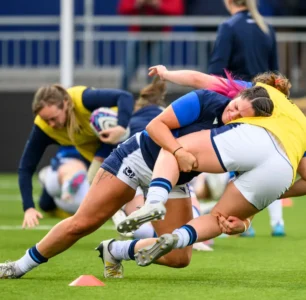Tackling in rugby is the defensive technique used to stop the ball carrier and regain possession of the ball. Proper technique and positioning minimize the risk of injury while effectively neutralizing the opponent’s attack.
Master the fundamentals of tackling in women’s rugby, from proper technique to the mindset required for effective defensive play. Whether you’re a player honing your skills or a coach teaching the next generation, our guide has everything you need to know.
Tackling FAQ
- Tackling Rules
- Are players on their feet required to release the tackled player before contesting the ball?
Yes, players who make a tackle must release the tackled player and allow them to place the ball on the ground. Once the tackled player has done so, any player from either team can contest for possession by trying to legally secure the ball. Failure to release the tackled player can result in penalties.
- Can players on the attacking team use their hands to rip the ball from a tackled player's possession?
No, players on the attacking team cannot use their hands to steal the ball from a tackled player. However, they can contest for the ball once it’s on the ground by trying to secure possession through legal means, such as attempting to push the opponent off the ball or driving over it. This is known as a ruck.
- Can the tackler play the ball immediately after making the tackle?
No, the tackler must release the tackled player and allow them to place the ball on the ground before attempting to play it. Once the ball is on the ground, the tackler can try to contest for possession along with other players from both teams, following the rules governing rucks and breakdowns in rugby.
- Tackling
- What are the different types of tackles used in rugby defense?
In rugby defense, players use various types of tackles to stop the opposing team’s progress. Some common types include the “shoulder tackle,” where the defender uses their shoulder to make contact with the ball carrier, and the “wrap tackle,” where the defender wraps their arms around the ball carrier’s legs to bring them down.
- Correct body position for tackling
- How do players coordinate in a double tackle or gang tackle situation?
In a double or gang tackle situation, players communicate and coordinate to ensure effective execution. One player typically goes low to tackle the legs, while the other aims higher to prevent offloading. Communication and timing are key to avoid collisions and secure the tackle.
- What does tackling mean?
Tackling in rugby refers to the defensive technique used to stop the opposing player who is carrying the ball. It involves using physical contact to bring the ball carrier to the ground, either by wrapping them up and driving them down or dislodging the ball from their possession.
- What is the proper technique for tackling in rugby?
- What's the difference between a dominant and passive tackle in rugby?
In rugby, a dominant tackle is when the defender aggressively takes down the ball carrier, often resulting in a loss of ground or possession for the attacking team. A passive tackle, on the other hand, may involve less force and can sometimes allow the ball carrier to gain momentum or offload the ball.

